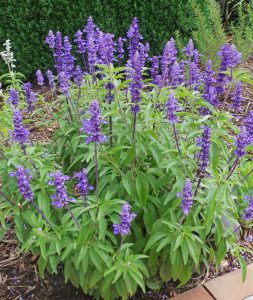
Mealycup sage, Salvia farinacea, is native to the plains, prairies, meadows and woodland edges of Mexico, central and western Texas and New Mexico in limestone soils from 3500-6000 feet. Also commonly called mealy blue sage, mealy sage, or blue sage, this short lived herbaceous perennial in the mint family (Lamiaceae) is hardy in zones 7-10. Because it is fast-growing and bears multiple spikes of blue flowers in its first year (flowering in less than four months from seed), it is frequently grown as an annual where it will not survive the winter.
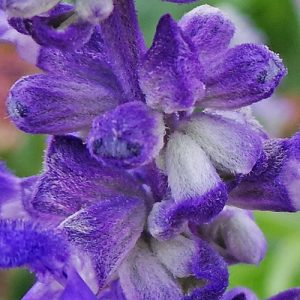
Both the scientific and common names refer to the powdery white felted hairs on the flower calyx and upper stems; this extremely fine white pubescence is referred to as farinose (“mealy” means covered with powdery meal; farina is Latin for flour or meal).
This upright to sprawling plant can form a mound of foliage up to 4 feet tall and wide. The long (to 3”), drooping, lance-shaped, nearly-glossy leaves grow in dense clusters (opposite to whorled) from the square stems. Most salvias have hairy or velvety leaves, so the shiny leaves set this species apart. The aromatic leaves may or may not be irregularly-serrate or toothed. They are a soft gray-green to nearly silver in color, especially on the undersides.
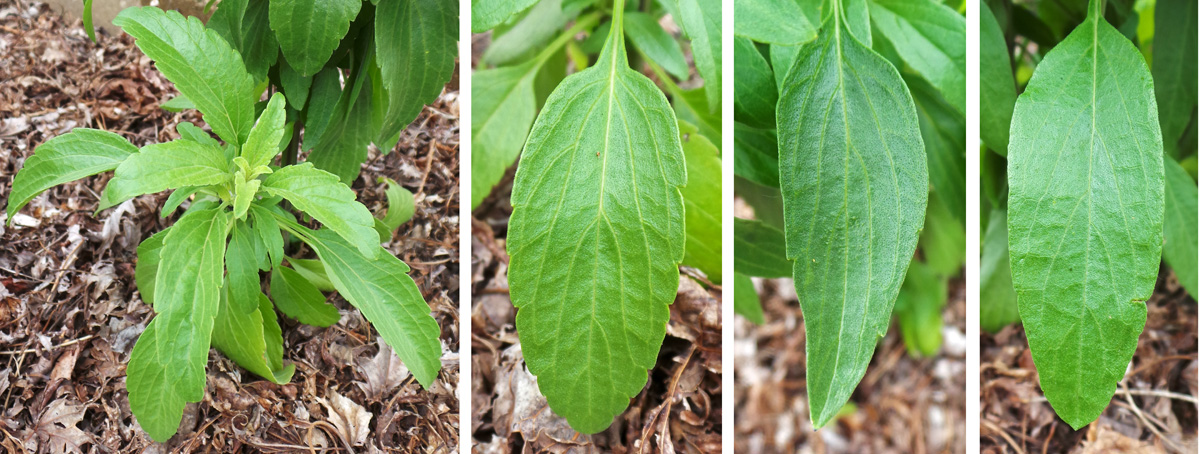
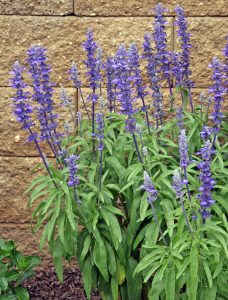
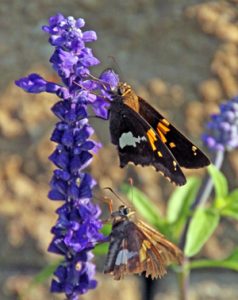
Plants bloom from early summer to frost on tall, sturdy flower stems growing from the clusters of leaves in axillary and terminal racemes that somewhat resemble lavender. Dark blue, light blue, purple, or white flowers are borne in dense whorls along each 4- to 8-inch long flower spike. Each flower has the 5 lobes and 2 lips typical of the salvias. They are up to ¾ inch long with 2 stamens and 1 pistil. Butterflies, bees and hummingbirds find the lightly fragrant (often described as grape scented) flowers very attractive. The flower spikes can be cut to use in fresh or dried arrangements. Goldfinches will eat the seeds in the small, dry brown fruits that follow the flowers.


Use mealycup sage in annual or mixed beds or borders, as focal points or in mass plantings. It works well in cottage gardens or more formal styles of gardens to add vertical interest. It can also be used in containers or grown in cutting gardens. Include mealycup sage in wildlife or butterfly gardens because of its attraction to pollinators. The grayish foliage offers color contrast with the typical green foliage of most other plants or with dark-leaved plants, such as ‘Black Pearl’ ornamental pepper or ‘Dark Opal’ or ‘Purple Ruffles’ basil, or pair it with the silvery leaves of dusty miller. The upright blue flower spikes combine well with yellow or pink flowers on mounding or spreading plants such as lantana, marigolds, begonias or petunias. Or mix it up with taller annuals such as cosmos or tall zinnias for a colorful low seasonal hedge.
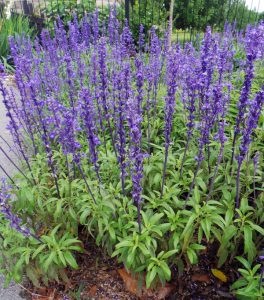
Grow mealycup sage in full sun to partial shade. It adapts well to nearly all types of soils (including heavy clay and sandy soils), and although it prefers good moisture levels, it is fairly drought tolerant once established. It will be weak and leggy in wet soils. Plants can be sheared back to promote a more compact plant, but this will delay flowering for several weeks. This plant has few problems other than aphids and powdery mildew in our climate, and is not attractive to deer.
Mealycup sage is easily propagated from seed, and self-sows in my Wisconsin garden, but not excessively, with plants starting to bloom by late summer if allowed to grow on their own. Seeds can be collected by bagging the old flower spikes to capture ripening seed. Light is required for germination, so just press the seed into the growing medium rather than covering it. Seeds should germinate in 10-30 days. Sow indoors 8-10 weeks before the average last frost date, and set out plants after the last frost. Plants sown outdoors after last frost may not bloom before the first frost in fall. Plants can also be propagated from softwood cuttings in spring through fall, or overwintered by cutting back and potting up in fall to keep indoors in a bright but cool sunny window.
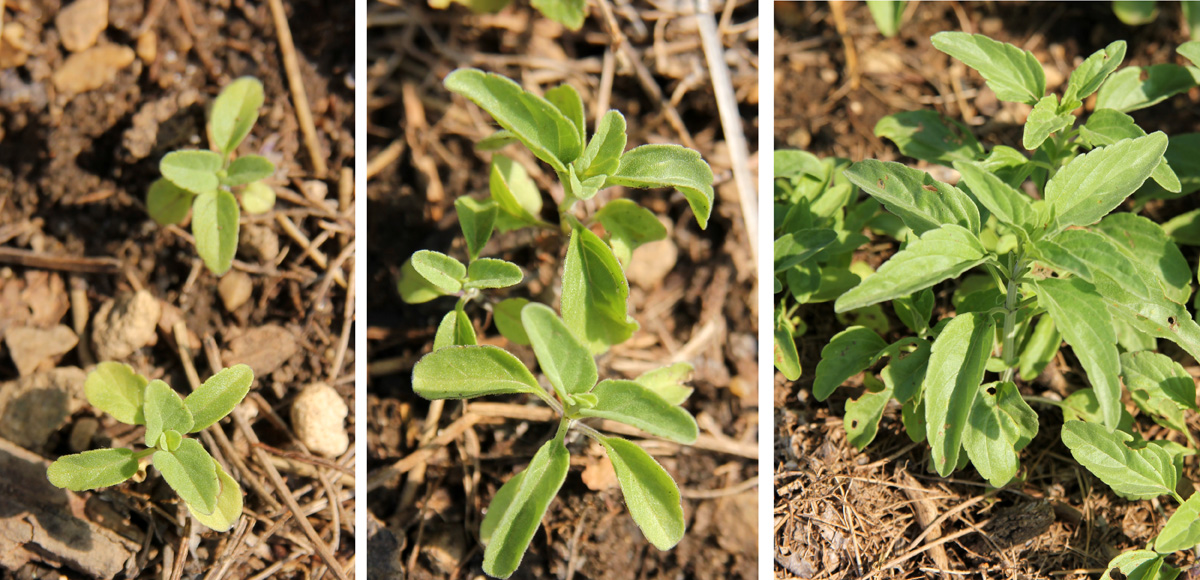
The species is rarely offered as an annual bedding plant in nurseries and garden centers, but there are many more refined cultivars and some hybrids that are commonly available, either as plants or seeds, including:
- ‘Art’s Bicolor’ is a selection from Austin, TX with dusky violet flowers with strong white beelines. The related selection ‘Art’s Blue’ has solid colored flowers.
- ‘Augusta Duelberg’ is a large but dense variety (30 inches tall by 4 feet wide) producing hundreds of spikes of silvery-white flowers. ‘Henry Duelberg’ is a bit taller with blue flowers. Both were discovered growing in an old, untended Texas graveyard (and named after the tombstones where they were found), so obviously are very heat- and drought-tolerant.
- ‘Blue Bedder’ is a dwarf form that only grows to about 1 foot tall as an annual (taller where perennial).
- ‘Blue Frost’ is a Proven Winners selection with blue bracts and lavender flowers that grows 1-2 feet tall.
- ‘Evolution’ is more compact and florific than other selections and won an All-America Selections award in 2006 because of its masses of deep violet-purple flowers on 16” tall plants.
- ‘Fairy Queen’ has a well-branched, compact habit similar to ‘Evolution’ and sapphire blue flowers with a small white spot on each (supposedly creating the “illusion of fairy dust”).
- ‘Indigo Spires’ is a cross of S. farinacea and S. longispcata (a seedling found at Huntington Botanic Gardens in Pasadena, California, in the 1970’s) that is very heat- and drought-tolerant, with velvety purple-blue flowers on tall spikes up to 2 feet tall on the large plants (3-5 feet tall and wide where perennial).
-
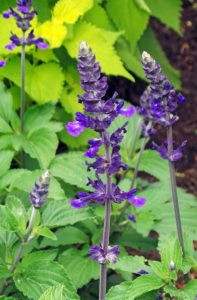
‘Mystic Spires Blue’
‘Mystic Spires Blue’ is another cross of S. farinacea and S. longispcata with tall spikes of blue flowers on plants that grow to 18 inches tall and 24 inches wide. - ‘Rhea’ is compact (12-16 inches) with purple-blue flowers on dark purplish stems.
- ‘Strata’ grows about 18 inches tall and has clear blue flowers with a white calyx for a two-tone effect. It was awarded the Fleuroselect Gold Medal for its unique color and excellent performance in the garden and was a 1996 All America Selections Winner.
- Texas Violet™ is a larger, looser (3 to 4 feet tall by 1 to 2 feet wide) selection discovered by Greg Starr of Starr Nursery in Tucson, Arizona with deep indigo petals and lightly hairy white sepals. It is intended to be grown as a perennial rather than as an annual. [This selection was discovered by Greg Starr of Starr Nursery in Tucson and was a joint introduction with Mountain States Wholesale Nursery in Phoenix. The name ‘Texas Violet’ is a registered Arizona trademark (#41921) that is owned by Mountain States Nursery.]
- Velocity™ is an early bloomer that features large, dark blue flower spikes and a dense habit.
- ‘Victoria’ is very robust, densely-branched variety, with large, intense violet-blue flowers and dark stems. It grows 15-24” inches tall. This is the most common cultivar sold in the North and tolerates shade better than most. There is also a ‘Victoria White’ with white flowers.

– Susan Mahr, University of Wisconsin – Madison
Additional Information
- Salvia farinacea ‘Victoria Blue’ – on the Missouri Botanic Garden’s Kemper Center for Home Gardening website
- Salvia farinacea – on the Floridata website
- Salvia farinacea – on the Lady Bird Johnson Wildflower Center website





 Marigolds
Marigolds Create a Butterfly Garden
Create a Butterfly Garden Plant Flowers to Encourage Beneficial Insects
Plant Flowers to Encourage Beneficial Insects Forcing Bulbs
Forcing Bulbs


